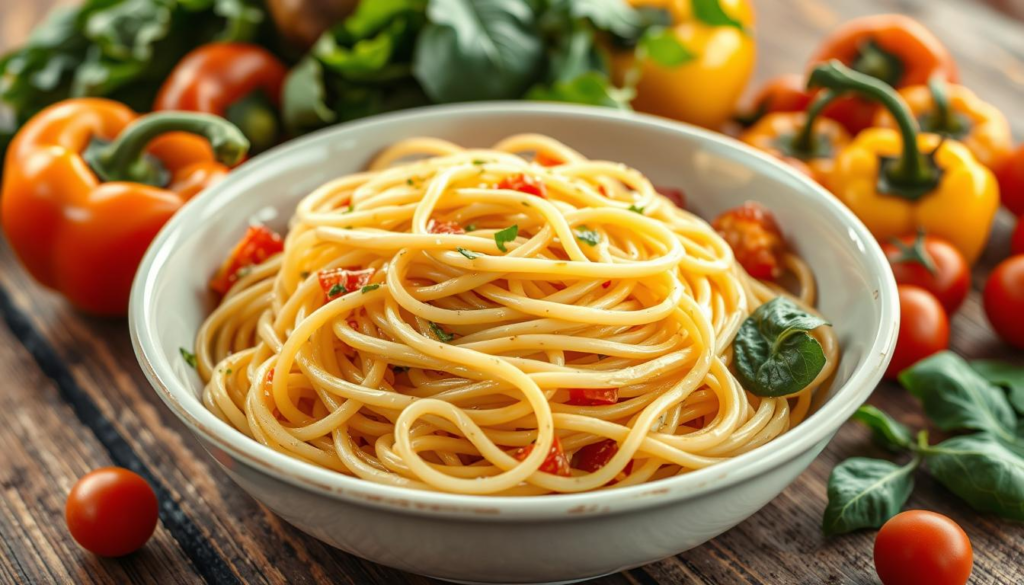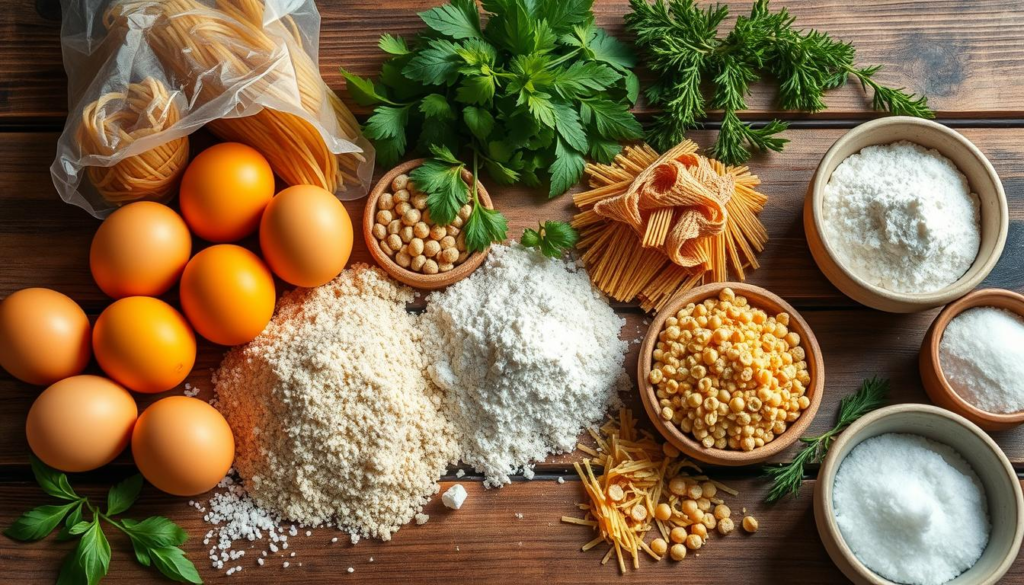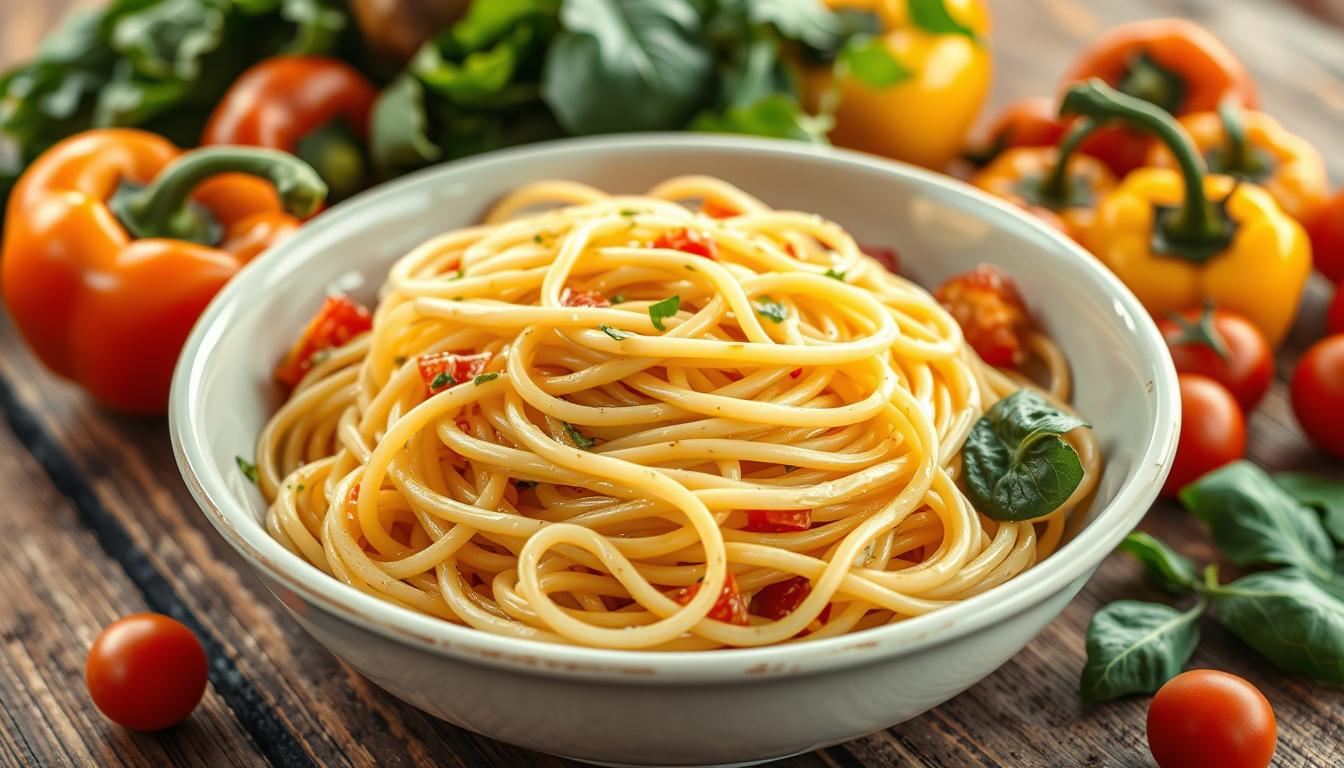Finding tasty wheat-free noodles is easier than you think. I’ve been on a journey to find great alternatives for pasta lovers. Gluten free egg noodles are perfect for those with celiac disease or gluten sensitivity.

This guide will teach you all about gluten-free egg noodles. It will cover ingredients, cooking techniques, and delicious recipes, and you will see how these special noodles can make your cooking unforgettable.
Table of Contents
Understanding Gluten Free Egg Noodles: A Complete Guide
Gluten-free pasta has changed the game for those with dietary needs or who want healthier options. It lets people enjoy their favourite pasta dishes without losing taste or nutrition.
Benefits of Choosing Gluten-Free Options
Choosing allergen-free noodles has many benefits for your diet. These unique pasta options help those with health concerns:
- Improved digestive health for those with gluten sensitivity
- Reduced inflammation in the body
- Enhanced nutrient absorption
- Increased variety in dietary choices
Common Ingredients in Gluten-Free Noodles
Making tasty gluten-free pasta needs creative ingredients. Makers use different flours to get the right noodle texture:
- Rice flour
- Corn flour
- Quinoa flour
- Almond flour
- Chickpea flour
Nutritional Value and Dietary Considerations
Knowing what’s in gluten-free egg noodles can help you make better choices. If made right, these noodles can be full of important nutrients.
Gluten-free pasta often has as much protein and fibre as regular noodles. Choosing top-notch ingredients means you get the most nutrition while enjoying tasty meals.
Essential Ingredients for Perfect Gluten Free Egg Noodles

Making delicious grain-free pasta needs the right ingredients. These ingredients turn your noodles into a special treat. Knowing what to use is key for the perfect taste and texture.
The success of your noodles depends on the ingredients you choose. Here’s what you’ll need:
- Gluten-free flour blends: Almond flour, rice flour, or cassava flour work best
- Eggs (fresh and room temperature)
- Xanthan gum or psyllium husk (as a binding agent)
- Salt
- Olive oil or melted butter
Choosing the right flour is crucial for your pasta. Each flour adds its unique touch:
| Flour Type | Texture | Flavor Profile |
|---|---|---|
| Almond Flour | Soft, tender | Nutty, rich |
| Rice Flour | Light, delicate | Neutral |
| Cassava Flour | Chewy, elastic | Mild, slightly sweet |
Your binding agents are very important. Xanthan gum helps your noodles stay together. For the best results, use about 1/2 teaspoon for every cup of flour.
Pro tip: Always use fresh, high-quality ingredients for the best results in your grain-free pasta adventure.
Step-by-Step Recipe Instructions
Making delicious wheat-free noodles at home is simple. This guide will show you how to make gluten-free egg noodles that everyone will love.
Mixing and Kneading Techniques
When making eggless noodles, please be sure to be precise. First, could you mix your gluten-free flour blend? This usually includes rice flour, cornstarch, and potato starch. Please combine the dry ingredients well before adding the wet ones.
- Combine gluten-free flour mix in a large bowl
- Create a well in the centre for liquid ingredients
- Blend eggs or egg substitutes carefully
- Knead dough until smooth and elastic
Rolling and Cutting Methods
Use a pasta machine or rolling pin to make thin, uniform sheets and achieve the perfect texture and thickness.
- Dust your work surface with gluten-free flour
- Roll dough to approximately 1/8 inch thickness
- Cut into desired noodle shapes
- Separate noodles to prevent sticking
Cooking Time and Temperature Guidelines
| Noodle Type | Water Temperature | Cooking Time |
|---|---|---|
| Fresh Gluten-Free Noodles | Boiling (212°F) | 2-3 minutes |
| Dried Gluten-Free Noodles | Boiling (212°F) | 4-6 minutes |
Keep an eye on your noodles while they cook. Gluten-free egg noodles can become mushy if overcooked. Check if they’re done by tasting a small piece. They should be tender but not too soft.
Best Storage Practices and Make-Ahead Tips

When you make gluten-free pasta at home, it’s key to store it right. Proper care ensures your noodles stay fresh and full of flavour, and it also ensures they remain tasty and have the right texture.
Here’s how to store your homemade gluten-free noodles:
- Refrigerate fresh gluten-free egg noodles in an airtight container
- Consume refrigerated noodles within 2-3 days for optimal taste
- Separate noodle layers with parchment paper to prevent sticking
Freezing is a great way to keep your gluten-free pasta for longer. Here’s how to do it:
| Storage Method | Duration | Recommended Technique |
|---|---|---|
| Refrigeration | 2-3 days airtight | ht container, layer with parchment |
| Freezing | Up to 4 weeks | Dust with rice flour and freeze in flat portions |
To freeze your noodles, you can prepare them first. Dust noodles lightly with rice flour before freezing to prevent clumping. Please place them in single layers on baking sheets. Once they’re frozen solid, move them to freezer bags.
For those who love gluten-free pasta, here’s a tip: Label your containers with the date you made them. This way, you can always know how fresh your noodles are. Your homemade noodles will stay delicious and be ready for a quick meal.
Delicious Sauce Pairings and Serving Suggestions
Exploring gluten-free egg noodles opens a world of flavours. These versatile noodles make meals that please everyone’s taste and dietary needs.
Classic Italian-Style Preparations
Your special diet pasta can shine with traditional Italian sauces. Try these tasty combinations:
- Creamy Alfredo sauce with fresh herbs
- Rich tomato marinara with basil
- Garlic and olive oil with parmesan cheese
Asian-Inspired Serving Ideas
Gluten-free egg noodles are plentiful in Asian dishes. Enjoy these exciting flavours:
- Sesame stir-fry with vegetables
- Spicy peanut sauce with grilled chicken
- Ginger-soy reduction with shrimp
Family-Friendly Dish Combinations
Make meals that everyone will love with these noodle combinations:
| Dish | Sauce Type | Protein Option |
|---|---|---|
| Comfort Casserole | Cheese Sauce | Ground Turkey |
| Pasta Primavera | Light Cream Sauce | Grilled Vegetables |
| Beef Stroganoff | Sour Cream Sauce | Lean Beef Strips |
Dietary noodles can change your cooking, offering tasty options for special diets. Try different sauces and ingredients to find your favourite gluten-free egg noodle dishes.
Related: Easy Garlic Parmesan Chicken Pasta

